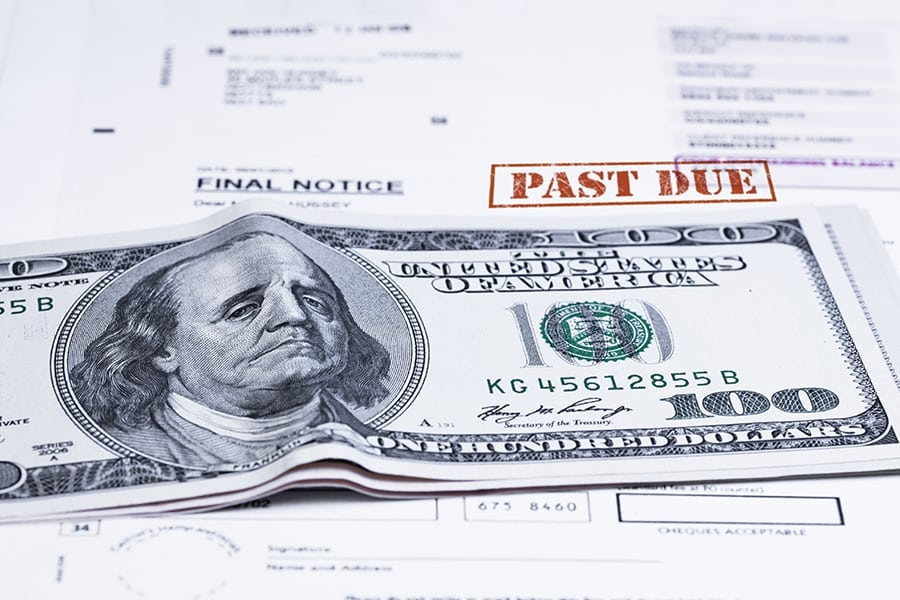Ahh… Delaying the inevitable through student loan deferment.
Starting an article like this with a question like, “Why defer your student loans,” would be a stupid thing to do. You would rightfully reply, “Because I’m having financial difficulty, you idiot!”
With this in mind, let’s cut to the chase.
Let’s get into what student loan deferment and forbearance are, and work backward.
The two are connected.
The purpose of both is to avoid default.
With most student loan programs, you have to try really hard, ignoring notices for a long time, before they consider your loan defaulted.
I’ll stress this a lot throughout: stay on top of this! No challenge just goes away…
(NOTE: Deciding between a deferment or a forbearance? Don’t make any moves before reading this FREE guide: 10 Things You Should Know About Student Loan Deferment and Forbearance in 2017. Find out which option is best for you and how to apply for the right one the right way. Click here to learn more and get your free guide.)
Student Loan Deferment
If you meet certain eligibility requirements, deferment or forbearance allows you to temporarily stop making payments or to temporarily reduce your monthly payment amount for a specified period of time.
You’ll need to work with your loan servicer to apply for deferment or forbearance.
You should also be sure to keep making payments on your loan until the deferment or forbearance is officially in place. Your loan servicer will notify you if you can temporarily stop paying, if further information is needed, or if you do not qualify.
Deferment
With a student loan deferment, you may not be responsible for paying the interest that accrues on certain types of loans during the deferment period.
Some loan types where you may NOT be responsible for the interest that builds up (accrues) are:
- Direct Subsidized Loans
- Subsidized Federal Stafford Loans
- Federal Perkins Loans
- The subsidized portion of Direct Consolidation Loans
- The subsidized portion of FFEL Consolidation Loans
However, during deferment, you ARE responsible for interest that accrues on the following:
- Direct Unsubsidized Loans
- Unsubsidized Federal Stafford Loans
- Direct PLUS Loans
- The unsubsidized portion of Direct Consolidation Loans
- The unsubsidized portion of FFEL Consolidation Loans
Generally speaking, with these loans, your loan provider will not have you making the monthly interest payments during deferment.
Instead, they’ll inform you that interest will build up and then be added to the balance of the loan.
Most folks accept this arrangement.
This is because, well…you’re not able to pay right now or else you’d be paying, right?
Unpaid interest is only capitalized on Direct Loans and FFEL Program loans, never on Perkins Loans.
Am I Eligible for Student Loan Deferment?
Eligibility is a big factor in understanding student loan deferment.
The most obvious criteria you have to meet? Enrollment in a school.
Here are a few more:
- Enrollment at least half-time at an eligible college or career school, and if you received a Direct PLUS Loan or FFEL PLUS Loan as a graduate or professional student, for an additional six months after you stop being enrolled at least half-time. This is called an In-School Deferment Request.
- Status as parent who received a Direct PLUS Loan or a FFEL PLUS Loan, while the student for whom you obtained the loan is enrolled at least half-time at an eligible college or career school, and for an additional six months after the student stops being enrolled at least half-time. This is called the Parent PLUS Borrower Deferment Request.
- Enrollment in an approved graduate fellowship program. This is called the Graduate Fellowship Deferment Request.
- Enrollment in an approved rehabilitation training program for the disabled. This is called the Rehabilitation Training Program Deferment Request.
- Unemployment or inability to find full-time employment, for up to three years. This is called the Unemployment Deferment Request.
- Economic hardship or serving in the Peace Corps. This can apply for up to three years. This is called the Economic Hardship Deferment Request and is the most commonly used. Though it is more often used by the former than the latter!
- Enrollment in active duty military service in connection with a war, military operation, or national emergency. This is called the Military Service and Post-Active Duty Student Deferment Request, OR
- History of active duty military service in connection with a war, military operation, or national emergency, for the 13 month period following the conclusion of that service, or until you return to college or career school on at least a half-time basis, whichever is earlier. This is called Military Service and Post-Active Duty Student Deferment Request.
The parent plus borrower deferment is available only to parents who received Direct PLUS Loans or FFEL PLUS Loans.
All of the other deferments described above are available to Direct Loan, FFEL Program loan, and Perkins Loan recipients.
(NOTE: Wondering how to defer your student loans? Don’t make any moves before reading this FREE guide: 10 Things You Should Know About Student Loan Deferment and Forbearance in 2017. Find out which option is best for you and how to apply for the right one the right way. Click here to learn more and get your free guide.)
If you received a Perkins Loan, you may also be eligible for a deferment while you are working towards cancellation on your Perkins Loan.
Find out whom to contact for more information about your Perkins Loan.
In most cases, Perkins Loan recipients who receive a deferment will receive a six-month post deferment grace period that begins on the date they no longer meet the deferment eligibility requirements.
You are not required to pay during the post-deferment grace period.
If you are a Direct Loan borrower who had a balance on a FFEL Program loan that was made before July 1, 1993 at the time you received your first Direct Loan, or if you are a FFEL Program loan borrower who received loans before July 1, 1993, you may be eligible for additional deferments or your deferment options may be different from the deferments described above.
But don’t just guess here!
Contact your loan servicer and they’ll fill you in.
Am I Eligible for Forbearance?
It depends.
There are two types of forbearance; General and Mandatory.
General Forbearance
Your loan servicer decides whether or not to grant a request for a general forbearance.
That is why this request process is sometimes called discretionary forbearance.
You can request general forbearance if you are temporarily unable to make your scheduled monthly loan payments for the following reasons:
- Financial difficulties
- Medical expenses
- Change in employment
- Other reasons acceptable to your loan servicer
General forbearances are available for Direct Loans, FFEL Program loans, and Perkins Loans.
For loans made under all three programs, general forbearances may be granted for no more than 12 months at a time.
If you are still experiencing a hardship when your current forbearance expires, you may request another general forbearance.
For Perkins Loans, there is a cumulative limit on general forbearance of three years. There is no fixed cumulative limit on general forbearance for Direct Loans and FFEL Program loans.
However, your loan servicer may set a limit on the maximum period of time you can receive a general forbearance.
For more information, review the General Forbearance Request.
Mandatory Forbearance
Under this type of forbearance, your loan servicer is required to help you out here!
They must grant the forbearance.
BUT only if:
- You are serving in a medical or dental internship or residency program, and you meet specific requirements (Direct Loans and FFEL Program loans only). This is called the Mandatory Forbearance Request: Medical or Dental Internship/Residency, National Guard Duty, or Department of Defense Student Loan Repayment Program. It’s a mouthful, but it’s worth it!
- The total amount you owe each month for all the student loans you received is 20 percent or more of your total monthly gross income, for up to three years (Direct Loans, FFEL Program loans, and Perkins Loans). This is called the Mandatory Forbearance Request: Student Loan Debt Burden.
- You are serving in an AmeriCorps position for which you received a national service award (Direct Loans and FFEL Program loans only). You would request an AmeriCorps forbearance. On this one you’re eligible ONLY if you received a national service award, so don’t get cute.
- You are performing a teaching service that would qualify you for teacher loan forgiveness (Direct Loans and FFEL Program loans only). You’d ask Teacher Loan Forgiveness Forbearance Request.
- You qualify for partial repayment of your loans under the U.S. Department of Defense Student Loan Repayment Program (Direct Loans and FFEL Program loans only). You’d ask for a Mandatory Forbearance Request: Medical or Dental Internship/Residency, National Guard Duty, or Department of Defense Student Loan Repayment Program, OR
- You are a member of the National Guard and have been activated by a governor, but you are not eligible for a military deferment (Direct Loans and FFEL Program loans only). You’d ask for a Mandatory Forbearance Request: Medical or Dental Internship/Residency, National Guard Duty, or Department of Defense Student Loan Repayment Program. It’s another mouthful, but you get the idea.
Mandatory forbearances may be granted for no more than 12 months at a time.
If you continue to meet the eligibility requirements for the forbearance when your current forbearance period expires, you may request another mandatory forbearance…because well, they’re mandatory!
(NOTE: Deciding between a deferment or a forbearance? Don’t make any moves before reading this FREE guide: 10 Things You Should Know About Student Loan Deferment and Forbearance in 2017. Find out which option is best for you and how to apply for the right one the right way. Click here to learn more and get your free guide.)
Is student loan deferment or forbearance right for me?
If you are struggling to repay your loans due to a temporary circumstance, deferment or forbearance may be a good short-term solution.
However, if you are having trouble repaying your loans due to circumstances that may continue for an extended period, an income-driven repayment plan may be a better option for you.
You should also consider switching to an income-driven plan if you are unsure when you will be able to afford to make your monthly loan payments again.
Income-driven repayment plans base your monthly payments on your income and family size.
In some cases, through this plan, your payment could be as low as $0 per month. They can also provide loan forgiveness if, after 20 or 25 years, you still have not repaid your loan.
Always contact your loan servicer immediately if you are having trouble making your student loan payments.
Just like the IRS, most of your loan programs will garnish wages and levy bank accounts if they go ignored too long.
Regardless of the stress you may be under, stay on top of this.
These institutions are a business, period.
It should go without saying, your loan provider could accept a wide variety of deferment reasons.
Moving forward, know that there are limits on how many times you can ask for a student loan deferment or forbearance.
When you choose deferment or forbearance, really make it count.
Do you have a personal experience with student loan deferment? Let us know your story in the comments below!
Up Next: Student Loan Refinancing Companies | Which Can Get You Out of Debt
(NOTE: Deciding between a deferment or a forbearance? Don’t make any moves before reading this FREE guide: 10 Things You Should Know About Student Loan Deferment and Forbearance in 2017. Find out which option is best for you and how to apply for the right one the right way. Click here to learn more and get your free guide.)



I was in an accident and I’m on disability now, do I qualify for a deferment
Dept of Education is taking loan payments from my Social Security. This is causing financial problems mfor me.